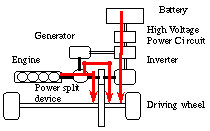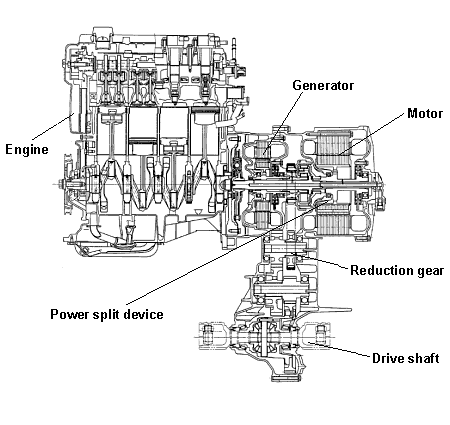Apr. 17, 2003
Toyota's Develops New Hybrid System
High-voltage Control Architecture Increases Efficiency,
Driving Pleasure
Tokyo―TOYOTA MOTOR CORPORATION announced today it has completed a next-generation hybrid system that radically enhances the synergy between electric motor and internal combustion engine by employing a high-voltage power-control system for greater motor output. THS II―developed under Toyota's "Hybrid Synergy Drive" concept―boasts improved environmental performance and drastically raises the "fun to drive" quotient for hybrid vehicles.
The new system represents the latest evolutionary stage in Toyota hybrid technologies, starting with those constituting the Toyota Hybrid System (THS) that powered the Toyota Prius into history books in 1997 as the world's first mass-produced hybrid passenger vehicle. Like THS, THS II places greater emphasis on the role of the motor than do systems that use a low-output motor to temporarily supplement a primary-drive-force engine.
As the world's leading manufacturer of hybrid vehicles, Toyota has aimed to revolutionize the automobile for the 21st century. Following the Prius, it introduced the THS-C-driven Estima Hybrid featuring a continuously variable transmission and the THS-M-propelled mild hybrid Crown, both in 2001. The technologies used in THS and its derivatives made possible the commercial launch of the TOYOTA FCHV fuel cell hybrid vehicle in 2002. Toyota has now sold more than 130,000 hybrid vehicles worldwide.
|
Plans include efforts to heighten THS II’s performance for application in heavy vehicles that require larger engines. The next-generation Prius, which features the new system, is currently on display at the ongoing New York International Automobile Show.
| 1. In pursuit of world-leading fuel efficiency |
|
Although THS II is based on the THS in the first-generation Prius, it is vastly more efficient due to its use of increased voltage in the electrical system for the motor and generator, which greatly reduces energy loss during transmission, and due to advancements in total vehicle energy efficiency.
In keeping with the principles of THS, which places key importance on the motor, THS II uses a high-efficiency motor that has one of the highest output densities (output per unit of battery volume) in the world in its class. The system features a high-efficiency engine that works together with the high-output motor, achieving even greater efficiency, unlike systems that rely on an engine as their primary driving force supplemented by temporary power from a low-output motor. In low-speed conditions that do not allow for optimum engine efficiency, the new system ensures that the engine is completely turned off and the vehicle is run only from power generated by the motor. Under normal conditions, the highly efficient engine functions as the primary power source and a power split device distributes the engine power between power generation and vehicle drive. The system continuously controls ratios of power generation and drive power distribution to achieve maximum energy efficiency. Furthermore, for the best fuel efficiency possible, THS II uses a new brake system and a new regenerative braking system that combines with a higher-performance battery and a system setup that significantly reduces loss during energy transmission for greater energy regeneration. |
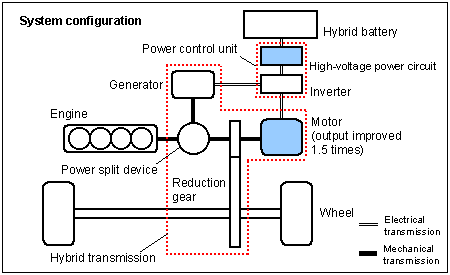
In addition to the 1.5 times more power generated by the motor, a significant improvement in drive power when coupled with the engine has been achieved over a wide range of speeds thanks to a considerable increase in the maximum rpm of the generator.
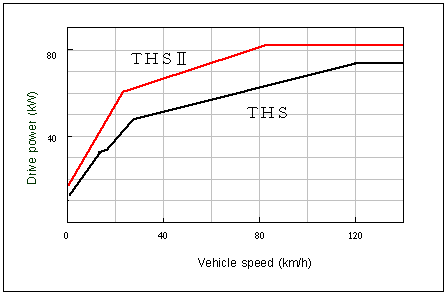
THS II can achieve acceleration performance greater than that of a conventional car with a 2-liter engine. It provides better acceleration response that is shock-free, smooth and powerful.
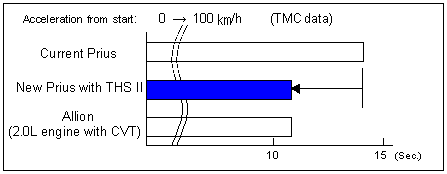
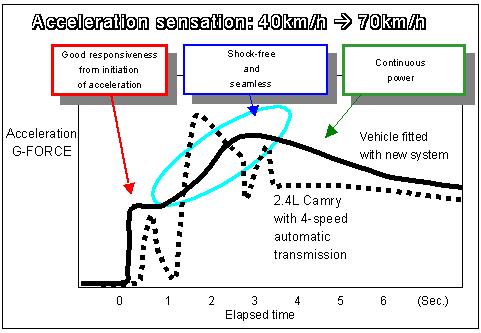
| 3. Technology behind the new system |
| High-voltage electrical system |
| A newly developed high-voltage power circuit boost current voltage between the motor, the generator and the hybrid vehicle battery to 500V, allowing the motor and generator to produce drive power at a high voltage, realizing a reduction in the power loss that occurs when supplying electricity with a small current and greater output from the motor. |

| Synchronous AC motor |
| The motor was developed completely in-house by TMC. The optimum placement of the permanent magnet of the motor's rotor, the effective shape of the rotor itself and use of a high-voltage power circuit give the motor an output 1.5 times greater than the output of the motor in the previous system without an increase in motor size. Also, the maximum torque distribution range has been expanded through improved motor control. |
| Hybrid Vehicle Nickel-Metal Hydride Battery |
| The newly developed high input/output performance hybrid vehicle battery boasts reduced internal resistance and unparalleled output density. Increased battery charge and discharge capacity contribute to improved acceleration performance and fuel efficiency. |
| Engine |
| The 1.5-liter Atkinson cycle engine, which achieves the world’s highest thermal efficiency for a gasoline engine, has been further modified, improving efficiency and enhancing driving performance through increased rpm. |
| System Operation |
|
| Operational status | |
| At acceleration from start and at low to mid-range speeds The engine is stopped when it encounters a poor-efficiency range under a wider range of operational conditions such as acceleration from standing start and up to mid-range speed. The vehicle runs entirely on power generated by the motor. |
 |
| During driving under normal conditions Power generated by the engine is distributed two ways by the power split device. One power stream is used to drive the generator, which in turn drives the motor. The other power stream is used to directly drive the wheels. The distribution of these power streams is controlled to provide maximum efficiency. |
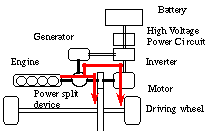 |
| During sudden acceleration During sudden acceleration, extra power is supplied from the battery while the engine adds drive to the high-output motor, providing good response and a smooth drive, as well as improved acceleration performance. |
 |
| During deceleration, such as through braking During deceleration, such as through braking, the high-output motor functions as a large capacity generator, controlling power distribution to the wheels. The system functions as an efficient regenerative braking system recovering the vehicle's kinetic energy as electrical energy. The recovered energy is then stored in the high-performance battery. |
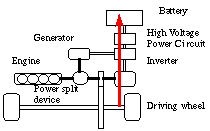 |
| While the battery is recharging The battery is controlled to maintain a certain level of charge. When the charge level becomes low the generator kicks in to recharge it. |
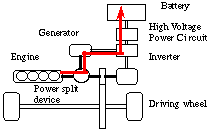 |
| When the vehicle is stopped, the engine automatically stops. |
| Item | THS II | THS | |
| Engine | Type | 1.5L gasoline (high-expansion ratio cycle) |
1.5L gasoline (high-expansion ratio cycle) |
| Maximum output in kw (Ps)/rpm | 57 (78)/5,000 | 53 (72)/4,500 | |
| Maximum torque in N-m (kg m)/rpm | 115 (11.7)/4,200 | 115 (11.7)/4,200 | |
| Motor | Type | Synchronous AC motor | Synchronous AC motor |
| Maximum output in kw (Ps)/rpm | 50 (68)/1,200 – 1,540 | 33 (45)/1,040 – 5,600 | |
| Maximum torque in N-m (kg m)/rpm | 400 (40.8)/ 0 – 1,200 | 350 (35.7)/ 0 - 400 | |
| System* | Maximum output in kW (Ps)/vehicle speed km/h |
82 (113)/85 or higher | 74 (101)/120 or higher |
| Output at 85km/h in kW(PS) | 82 (113) | 65 (88) | |
| Maximum torque in N-m (kg m)/vehicle speed km/h |
478 (48.7)/22 or lower | 421 (42.9)/11 or lower | |
| Torque at 22km/h in N-m (kg m) | 478 (48.7) | 378 (38.5) | |
| Battery | Type | Nickel-metal hydride | Nickel-metal hydride |
Cross-sectional view












